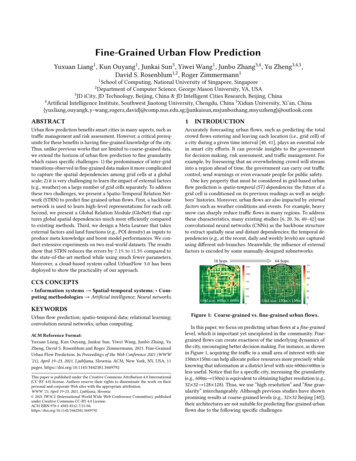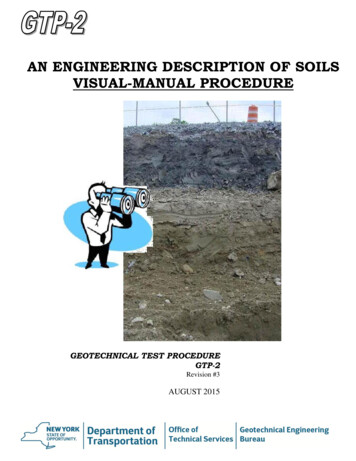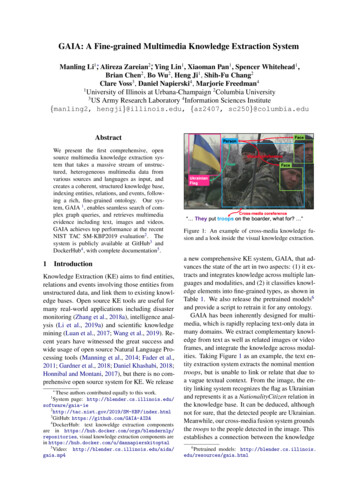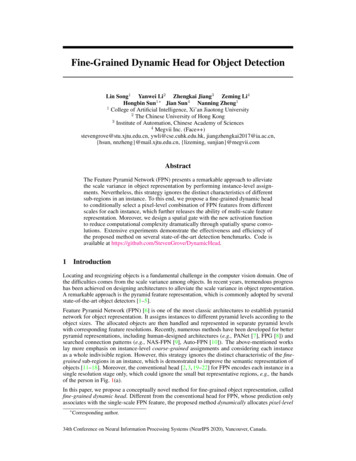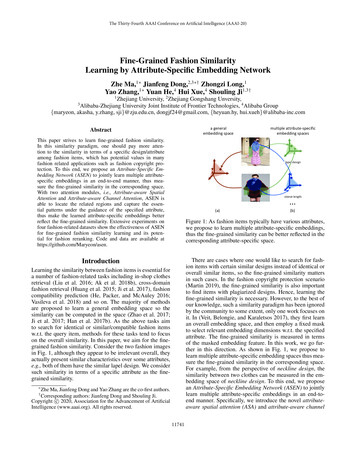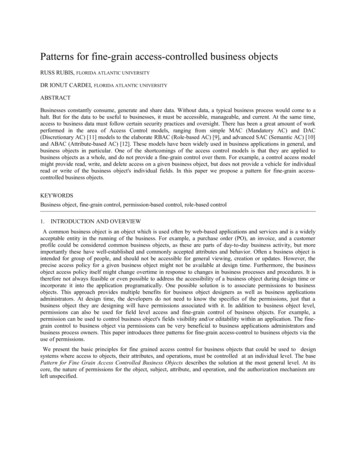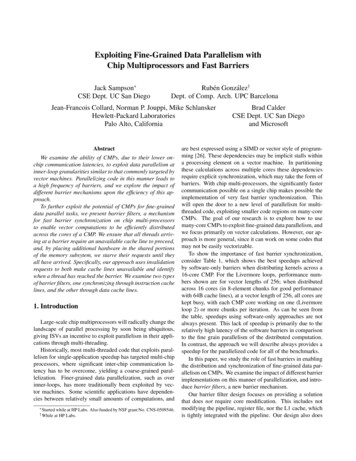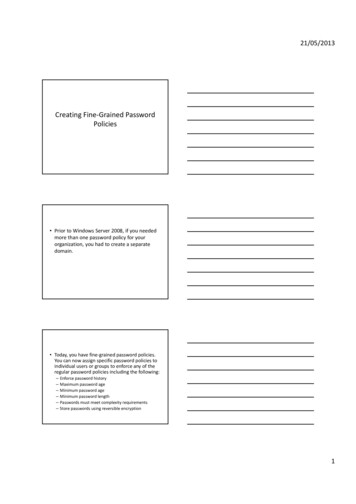
Transcription
Computer Networks 153 (2019) 1–10Contents lists available at ScienceDirectComputer Networksjournal homepage: www.elsevier.com/locate/comnetFine-grained data access control with attribute-hiding policy forcloud-based IoTJialu Hao a, , Cheng Huang b, Jianbing Ni b, Hong Rong a, Ming Xian a,Xuemin (Sherman) Shen babCollege of Electronic Science and Technology, National University of Defense Technology, Changsha, 410073, PR ChinaDepartment of Electrical and Computer Engineering, University of Waterloo, Waterloo, ON N2L 3G1, Canadaa r t i c l ei n f oArticle history:Received 30 June 2018Revised 6 December 2018Accepted 14 February 2019Available online 15 February 2019Keywords:Access controlAttribute-based encryptionAttribute hidingPolicy privacyCloud computingInternet of Thingsa b s t r a c tCiphertext-policy attribute-based encryption (CP-ABE) is a promising approach to achieve fine-grainedaccess control over the outsourced data in Internet of Things (IoT). However, in the existing CP-ABEschemes, the access policy is either appended to the ciphertext explicitly or only partially hidden againstpublic visibility, which results in privacy leakage of the underlying ciphertext and potential recipients. Inthis paper, we propose a fine-grained data access control scheme supporting expressive access policy withfully attribute hidden for cloud-based IoT. Specifically, the attribute information is fully hidden in accesspolicy by using randomizable technique, and a fuzzy attribute positioning mechanism based on garbledBloom filter is developed to help the authorized recipients locate their attributes efficiently and decryptthe ciphertext successfully. Security analysis and performance evaluation demonstrate that the proposedscheme achieves effective policy privacy preservation with low storage and computation overhead. As aresult, no valuable attribute information in the access policy will be disclosed to the unauthorized recipients. 2019 Elsevier B.V. All rights reserved.1. IntroductionInternet of Things (IoT) is the network of physical “things”,such as smart phones, sensors, and wearable devices, that enablesthese things to connect and exchange data, creating opportunitiesto improve our daily lives in different domains including electronichealthcare, smart home and transportation [1–3]. Almost 50 billion IoT devices will be connected together by 2020 [4], and theywill continuously produce large amounts of data which should bestored and processed in a well-organized way. In such situation,the traditional local data management is not scalable for large datavolume [5]. The cloud computing technology, which provides plentiful storage and computation resources, has been widely used tomaintain and manage these IoT-driven data [6,7].However, the data owners lose the physical control over theirdata after outsourcing them to the cloud [8]. The frequent dataleakage incidents [9–11] undermine trust in the cloud serviceprovider, which make data privacy and security be a serious con- Corresponding author.E-mail addresses: jialu.hao@uwaterloo.ca, j35hao@uwaterloo.ca (J. @uwaterloo.ca(J.Ni),qwertmingx@sina.com (M. Xian), sshen@uwaterloo.ca (Xuemin (Sherman) 1389-1286/ 2019 Elsevier B.V. All rights reserved.cern for data owners [12,13]. Although traditional encryption technology can be used to protect data confidentiality, it is relativelyinefficient to serve the needs of flexible data sharing. Thus, thenovel attribute-based encryption (ABE) [14] is applied to achievefine-grained access control and preserve data confidentiality simultaneously. Especially, ciphertext-policy attribute-based encryption(CP-ABE) [15] enables the data owners to encrypt their data under specified access policy over a set of attributes, and the datarecipients are allowed to decrypt the ciphertext only if their attributes satisfy the access policy associated with the ciphertext.However, in the conventional CP-ABE schemes [15,16], the accesspolicy is explicitly appended to the data ciphertext, thus anyonewho obtains the ciphertext, including the cloud service provider,may be able to infer some secret information about the data content or the privileged data recipients from the policy. For example, to share the medical records with the doctors or nursesin the Cardiology Department of Hospital A or B, a patient encrypts them under the access policy {[Occupation: (“Doctor” OR“Nurse”)] AND [Department: (“Cardiology”)] AND [Hospital: (“A”OR “B”)]}, and uploads the encrypted data including the policy explicitly to the cloud server. In such situation, anyone who obtainsthe ciphertext infers that the data owner may suffer from a heartproblem, although they do not obtain the plaintext. Even worse,
2J. Hao, C. Huang and J. Ni et al. / Computer Networks 153 (2019) 1–10the cloud service provider may conclude that the users who request these data regularly are working at the Cardiology Department of Hospital A or B. Obviously, such information disclosuresare not expected by both the data owners and recipients, whichmakes it necessary to preserve the privacy of access policy incertain applications, just like this sensitive electronic healthcaresystem.To solve the privacy leakage problem caused by the public access policy, a direct solution is to hide the attribute informationin the policy. However, the simple approach makes the decryptioninfeasible for the authorized recipients, since they do not knowwhich attributes should be used for decryption. Some proposedschemes [17–22] consider a trade-off between the policy privacyand the feasibility, in which the attribute is split into two parts:name and value. Instead of hiding the whole attribute, only theattribute value is concealed in the access policy. Though theseschemes can protect the policy privacy to some extent, the attribute name itself could still reveal some valuable information. Onthe other hand, inner-product predicate encryption (IPE) [23] canbe applied to construct a CP-ABE scheme with fully hidden policy,but the blow up in size caused by the access structure transformation makes it extremely inefficient [21].Recently, Yang et al. [24] put forward an innovative idea of removing the attribute mapping function ρ from the access policy(M, ρ ), which is in the form of linear secret sharing scheme (LSSS).Without sending ρ directly, they utilize a Bloom filter structure[25,26] to help the recipients to locate their attributes to the accessmatrix M precisely. However, their scheme is not secure against thedictionary attacks, which means anyone can query any attributefrom the Bloom filter to confirm whether it is in the access policy, and further recover the whole access policy through multipletrials.In this paper, we handle the above issue of policy privacypreservation by hiding the whole attribute. Based on the observation in [24], since the attribute mapping function ρ revealsthe relationship between the row and attribute in the expressive LSSS-based access policy (M, ρ ), removing it can effectivelyhide the attribute information. However, how to recover the relationship between their attributes and the access matrix M forthe authorized recipients, while resisting dictionary attacks, isa challenging problem. In our scheme, we propose a fuzzy attribute positioning mechanism based on garbled Bloom filter tohelp the recipients query the row numbers for their attributes, inwhich only authorized recipients are allowed to verify the validity of the results through successful decryption, while for unauthorized recipients no valuable attribute privacy can be compromised. Thus, we can realize fine-grained data access control on theoutsourced data, and protect both data confidentiality and policyprivacy.Our contributions are summarized as follows.1. We propose a fine-grained attribute-based data access controlscheme with attribute-hiding policy for cloud-based IoT. Different from existing schemes, our scheme supports expressive access policy and the attribute information is fully hidden.2. We design a fuzzy attribute positioning mechanism based ongarbled Bloom filter to assist the authorized recipients to locate the attributes effectively and decrypt the ciphertext successfully, and prevent the unauthorized recipients deducing anyvaluable attribute information from the ciphertext.3. We analyze the security and efficiency of our proposed scheme,and the further simulations demonstrate that the scheme canachieve effective policy privacy preservation with low storageand computation overhead.The remainder of this paper is organized as follows. We first introduce some related work in Section 2 and review several prelim-inary concepts in Section 3. The system model, security model anddesign goals are presented in Section 4, followed by the detailedconstruction of our proposed scheme in Section 5. Finally, we analyze the security and evaluate the performance in Section 6 andgive the conclusion in Section 7.2. Related workThe notion of attribute-based encryption (ABE) was first introduced by Sahai and Waters [14], which later develops into twoforms: ciphertext-policy ABE (CP-ABE) [15] and key-policy ABE(KP-ABE) [27]. Since CP-ABE enables the data owners to specifyfine-grained access policy for their data, it soon became popularin the outsourced data access control systems. In a CP-ABE system,the data owners encrypt the data under the access policy on thesystem attribute universe, and the data recipients request the secret key associated with their attributes from the attribute authority. If and only if the access policy of the ciphertext is satisfied bythe recipient’s attribute set, can it be decrypted successfully. Generally, according to the expression form, the access policy is divided into three categories: AND-based [17], tree-based [27] andLSSS-based [15]. The AND-based policy is limited in expressiveness and the tree-based policy is a more expressive one that supports the gates of AND, OR, and m of n threshold. In addition, anLSSS-based access policy is often considered as the most expressive representation, since any monotonic boolean formula can beconverted into this type[15].Currently, many ABE schemes with some new promising functionalities which make them more practical have been proposed,such as revocable ABE [28], lightweight ABE [29], outsourcing ABE[30] and large universe ABE [16]. However, most of the schemesexpose the access policy in clear text, which may incur privacyleakage, thus the research on anonymity of ABE is also necessary.In an anonymous ABE, the access policy is hidden such that theunauthorized recipients cannot presume what access policy is formulated by the data owners. The concept of partially hidden accesspolicy was introduced into ABE by Nishide et al. [17] to achieveanonymity, in which the attribute is split into an attribute nameand multiple attribute values, and only the attribute values areconcealed. Based on the scheme in [17], some works [18–20] improved the construction in terms of efficiency and security, butthey are still restricted with the less expressive AND-based access policy. Later, Lai et al. [21] put forward an anonymous CP-ABEscheme in the composite order groups, which partially hides theLSSS-based access policy. With the same form of the access policy,Cui et al. [22,31] proposed a more efficient scheme in the prime order groups on the basis of the large universe construction in [16],where opportunistic decryption tests are required for the authorized recipients. It might also be noted that all the above schemesfocus on the partially hidden access policy, but the public attributenames may also lead to the issue of privacy leakage. Some otherschemes [23,32] based on the inner-product predicate encryptionand hidden vector encryption are proposed to protect the policyprivacy, but the efficiency and expressiveness are restricted. Table 1shows the comparisons of some existing schemes in CP-ABE to preserve the policy privacy.Recently, Yang et al. [24] proposed a creative scheme to fullyhide the attribute information by removing the attribute mappingfunction ρ from the access policy, but their scheme is vulnerableagainst the dictionary attacks. In their scheme, anyone is allowedto query any attribute from the attribute Bloom filter to revealwhether it is in the access matrix and further recover the wholeaccess policy through multiple tests. To resist this dictionary attack, we design a fuzzy attribute positioning mechanism, in whichonly authorized recipients can obtain the attribute information bysuccessful decryption.
J. Hao, C. Huang and J. Ni et al. / Computer Networks 153 (2019) 1–103Table 1Comparisons of CP-ABE schemes with policy hidden.SchemesPolicy hiddenAccess policyGroup orderDecryption testBasic CP-ABE [15]Nishide et al. [17]Li et al. [18]Lai et al. [19]Zhang et al. [20]Lai et al. [21]Cui et al. [22]Michalevsky et al. [23]Khan et al. [32]Yang et al. [24]OursnoyesyesyesyesyesyesyesyesnoyesLSSSAND gates with multi-valuesAND gates with multi-valuesAND gates with multi-valuesAND gates with multi-valuesLSSS with multi-valuesLSSS with multi-valuesInner product predicatesLSSS with hidden ticab(disclosed attribute name)(disclosed attribute name)(disclosed attribute name)(disclosed attribute name)(disclosed attribute name)(disclosed attribute name)(whole policy hidden)(whole policy hidden)(whole attribute hidden)“deterministic” means that the number of decryption test is fixed, usually is one.“opportunistic” means that multiple tests may be required before finding the attributes for successful decryption.3. Preliminaries3.3. Bloom filterIn this section, we review some technical preliminaries relatedto our work.Bloom filter [25] is a space-efficient data structure for probabilistic set membership querying. A Bloom filter includes an m-bitarray to encode a set A including at most n elements, and a set ofindependent hash functions H, where each hi H maps an elementto a position index in [m] uniformly. In general, (m, n, k, H ) BFis used to represent a Bloom filter with parameters (m, n, k, H),BFA denotes a Bloom filter encoding the set A, and BFA [i] denotesthe value in the ith position of BFA .At first, each bit in the array is 0. To add an element x A tothe filter, x is hashed by k hash functions respectively to generate kposition indexes. Then, for each i [k], set BFA [hi (x )] 1. To querywhether an element y belongs to the set A, y is also hashed by thehash functions, and if there exists BFA [h j (y )] 0, then y A. Otherwise, y A with a high probability. A false positive exists in theBloom filter, which means it is possible that y A but all BFA [hj (y)]equal to 1. Given the size of A, the probability of false positive canbe adequately small by selecting m and k optimally.The garbled Bloom filter is proposed by Dong et al. [26] to dealwith the issue of private set intersection. Instead of using an arrayof bits, an array of η-bit strings is applied in the garbled Bloomfilter. To add an element x A to the filter, it is split into k shareswhich will be stored at the positions {hi (x)}i [k] . To query an element y, if the value recovered from the shares of the k positions{hi (y)}i [k] is equal to y, then y A, otherwise y is not in A.3.1. Access structureDefinition 1 (Access Structure [16]). An access structure on an attribute universe U is a collection A of non-empty sets of attributes.The sets in A are called the authorized sets. In addition, an accessstructure which satisfies the following requirement is called monotone: if B A and B C, then C A.In the CP-ABE scheme, only the user who has an authorizedattribute set is allowed to decrypt the ciphertext. In this paper, weonly consider the monotone access structure, and the concept ofaccess structure is also referred to as access policy in our context.3.2. Linear secret sharing schemeWe apply the linear secret sharing scheme to represent the access policy in our scheme.Definition 2 (LSSS [16]). Let p be a prime. A linear secret sharing schemewith a secret in Zp according to the access policy overan attribute universe U is called linear if:1. The shares of a secret s Zp assigned to each attribute constitute a vector over Zp .2. For an access policy over U, there exist an l n share-generatingmatrix, and an attribute mapping function ρ labeling each rowin M with an attribute in U, which satisfy that:With a column vector z (s, z2 , z3 , . . . , zn ), where z2 , z3 , . . . , znare random values in Zp , M z is the vector formed by the l shares of the secret s based on , and (M z ) j is the share assigned tothe attribute ρ (j). The pair of (M, ρ ) is referred to as accesspolicy.The linear secret sharing scheme satisfies reconstruction andsecurity requirements. Specifically, if S is an authorized set forthe policy (M, ρ ), there exist constants {ωi Zp }i I such that i I (ωi Mi ) (1, 0, . . . , 0 ), where I denotes the set of rows forwhich the corresponding attributes belong to S, i.e. I {i ρ (i ) S i [l]}1 Obviously, the secret s can be recovered through i I (ωi λi ) s. However, no such constant exists for any unauthorized set.1de f.For simplicity, in our context we define [n] {1, 2, . . . , n} for n N.4. System model and design goals4.1. System modelFour entities are included in our system, namely data owners,data recipients, attribute authority and cloud server, as shown inFig. 1. Data owners To save the local storage and computing cost, thedata owners would like to outsource the data generated by theIoT devices to the cloud. Meanwhile, fine-grained access controlover the outsourced data is desired by the owners, thus theywill use the CP-ABE scheme to encrypt the data before uploading them to the cloud. Data recipients The data recipients originate data requests tothe cloud server and receive the ciphertext. Only authorizedrecipients possessing attributes that satisfy the access policyof the data, can decrypt the ciphertext successfully. While forunauthorized recipients, they can neither recover the plaintext,nor guess the attributes involved in the access policy. Attribute authority The attribute authority manages the system attribute universe and distributes the attributes and corresponding private keys to the recipients according to their roles
4J. Hao, C. Huang and J. Ni et al. / Computer Networks 153 (2019) 1–105. Our proposed schemeIn this section, we first give an overview of the proposedscheme, and then describe the construction in detail of fourphases: 1) system setup; 2) key generation; 3) data encryption,and 4) data decryption. Our construction is on the basis of the CPABE scheme in [15], and the idea of the attribute-hiding policy canalso be used in other ABE schemes with LSSS-based access policy.Table 2 presents some notations used in our scheme.5.1. Scheme overviewFig. 1. System model.or credentials. In addition, the system public key is also generated and published by the attribute authority. Cloud server The cloud server is considered to have powerfulstorage and computing resources and is always online to provide services. It helps the data owners store and process theirdata, responses the requests from the recipients, and distributesthe corresponding data to them. Note that, in our system, thedata access control is embedded into the decryption, but notimplemented by the cloud server.4.2. Security modelIn our system, the attribute authority is regarded as a entirelycredible party and the data owners are honest as well. Since thecloud server is in different trust domain with the data owners, itis assumed to be semi-honest, which means it is interested in thedata privacy and is not reliable to make the access decisions ofthe data, but will execute the operations requested by the systemusers faithfully. The recipients are divided into two kinds: authorized and unauthorized. The authorized recipients are allowed toobtain the data content, and we assume that they will not leak thedata information actively. The unauthorized recipients are the potential attackers of the system. They may collude with each otherto attempt to decrypt the ciphertext which cannot be accessed individually, also they are interested in the policy privacy of the ciphertext.Note that, the dictionary attack is considered in our scheme,which means the attribute universe is public, such that the unauthorized recipients, even the cloud server, may conspire to compromise the hidden attribute information of the access policy bytesting all the system attributes.4.3. Design goalsConsidering the requirement mentioned in the system and security model, our goal is to design a fine-grained and privacy preserving data access control scheme supporting expressive accesspolicy with fully hidden attributes. Concretely, the following goalsshould be fulfilled. Fine-grained access control. The recipients whose attributes satisfy the access policy can decrypt the ciphertext to obtain thedata content, while those unauthorized recipients cannot eventhrough colluding. Privacy preservation of expressive policy. The expressive LSSSbased access policy should be supported. Meanwhile, the unauthorized recipients, include the cloud server, cannot compromise the attribute privacy of the access policy. Practical implementation. The underlying system operations,such as encryption and decryption, should be completed by thecorresponding entities effectively and efficiently.We propose a fine-grained and privacy preserving data accesscontrol scheme supporting expressive access policy with fully hidden attributes for cloud-based IoT. In our scheme, we apply the basic CP-ABE primitive to achieve flexible access control, and removethe attribute mapping function ρ from the access policy (M, ρ ) tohide the attribute information. To help the authorized recipientslocate their attributes to the access matrix, a fuzzy attribute positioning mechanism is designed based on a modified garbled Bloomfilter, which is referred to as attribute Bloom filter in our context.As shown in Table 3, to add an attribute attx to the originalgarbled Bloom filter [26], the value attx itself is inserted. Whilein [24], a unique value rownumx attx associated with the attributeattx is inserted, where rownumx is used to help the recipients toprecisely recover the corresponding row number in the access matrix M of attribute attx . However, since the attribute universe Umay be public, anyone including the cloud server can launch thedictionary attack, which means they are able to query any attributefrom the filter to make sure whether it is in the access policy, thusthe attribute privacy is still revealed. Different from their schemes,to add an attribute to the filter, a unique value binding with thecorresponding row number is inserted in our scheme. When therecipients look up the filter, a correct row number can be recovered for those attributes belonging to the policy, but a randomrow number for others. In addition, only authorized recipients canverify the validity of the row numbers for the attributes throughsuccessful decryption, thus the attribute privacy can be preservedeffectively.Generally, the following four algorithms are included in ourscheme. Setup(U) (PK, MSK) This algorithm takes as input the attribute universe U, and outputs the public key PK and the system master secret key MSK. KeyGen(PK, MSK, S) SKS This algorithm takes as input PK, MSKand a attribute set S, and generates the secret key SKS associated with S. Encrypt(PK, msg, (M, ρ )) CT This algorithm takes as inputPK, a message msg and an access policy (M, ρ ), and outputsthe ciphertext CT, where only M is included in the ciphertext.More specifically, two functions are included in the Encrypt algorithm: CTGen and ABFBuild.– CTGen: This function encrypts the data under the access policy, which can be seen as the encryption algorithm in thebasic CP-ABE scheme.– ABFBuild: This function constructs an attribute Bloom filterto hide the attribute information from the access policy. Decrypt(CT, SKS ) msg/ This algorithm takes as input the ciphertext CT and SKS associated with S, and returns the messagemsg if the attribute set S satisfies the access policy embeddedin CT. Otherwise, it returns with a overwhelming probability.It contains three functions: ABFQuery, MapRecover and DecTest.– ABFQuery: This function is used to query a row number fromthe attribute Bloom filter for each attribute in the recipient’sattribute set.
J. Hao, C. Huang and J. Ni et al. / Computer Networks 153 (2019) 1–105Table 2Notations used in our scheme.NotationsDescriptionsPK, MSKU {at t1 , . . . , at t U }hattxS {at t j }SKSMsystem public key and master secret keysystem attribute universepublic key components for attribute attx in Uattribute set of the data recipient, S Usecret key associated with attribute set San l n matrix in the access policyan attribute mapping function in the access policydata file to be uploadedfinal ciphertext uploaded to the cloudattribute Bloom filter T with parameters (m, n, k, H, η)a mapping function from attribute set S to a set of rows J [l]a submatrix of M including the rows belonging to J a set of minimum subsets of J such that for each I I there exists i I wi Mi (1, 0, . . . , 0 )ρmsgCT(m, n, k, H, η)-T MJITable 3Comparisons of value inserting.SchemesAdded attributeInserted valueDong et al. [26]Yang et al. [24]Oursattxattxattxattxrownumx attxξ l rownumx– MapRecover: This function helps to recover a set of the possible attribute mapping functions.– DecTest: This function is designed to test whether the Decrypt algorithm is successful, and returns the final result.5.2. Scheme description5.2.1. System setupThe attribute authority first executes the Setup algorithm withthe input of the attribute universe U {at t1 , . . . , at t U }. Let Gand GT be multiplicative cyclic groups of prime order p, g be agenerator of G, and e : G G GT be a bilinear map. The attribute authority randomly chooses α , β Z p and group elementshatt1 , . . . , hatt U G for all the attributes in U. The public key PK ispublished asP K e(g, g)α , g, gβ , hatt1 , . . . , hatt U The attribute authority sets MSK gα as the system master secret key.5.2.2. Key generationWhen the data recipient joins the system, the authority will assign an attribute set S U to him according to his roles or credentials, and run the KenGen algorithm to generate the correspondingsecret keys. KeyGen(PK, MSK, S) SKSThis algorithm takes as input PK, MSK and an attribute set S. Itchooses a random number t Z p , and computesD gα gβ t , D gt , attx S Dattx htattxFinally, the secret key is distributed to the recipient asSKS S, D, D , {Dattx }attx S5.2.3. Data encryptionTo achieve data confidentiality and fine-grained access control simultaneously, the data owner first specifies an access policy (M, ρ ) over U for the data msg. Then, it executes theEncrypt (P K, msg, (M, ρ )) algorithm to produce the ciphertext CTwhich will be uploaded to the cloud server.The Encrypt algorithm in our scheme includes two functions:CTGen and ABFBuild. The function CTGen is used to produce thereal ciphertext components and the function ABFBuild is designedto help the recipients locate their attributes to the access matrix M.Note that the second one is indispensable since the attribute mapping function ρ is removed from the final ciphertext CT to preventthe disclosure of attribute privacy in the access policy.1. CT Gen(P K, msg, (M, ρ )) CT0The function takes as input the public key PK, the data msg andthe access policy (M, ρ ), where M is an l n access matrix and ρ isan injective function that maps each row in M to a unique attributein U. It first selects random numbers s, z2 , . . . , zn Z p , and constructs a vector z (s, z2 , . . . , zn ). It calculates λi Mi · z for eachi [l], where Mi means the ith row of M. Here λi can be seen asthe secret share that is assigned to the attribute ρ (i). Then the ciphertext CT0 is produced asCT0 C msg · e(g, g)α s , C0 gs , {Ci gaλi h sρ (i ) }i [l]Remarks. In order to allow the recipient to test whether thedecryption succeeds, we can adopt the technique introduced in[33], in which two independent and uniform δ -bit symmetric keys(key1 , key2 ) are generated from a randomly selected value key GT .Then key is encrypted by running CT Gen(P K, key, (M, ρ )) CT0 . Inaddition, the data msg is encrypted under key1 with the symmetric encryption SEkey1 (msg ). Finally, the ciphertext is in the formC T (C T0 , key2 , SEkey1 (msg )). After decrypting key from CT0 , therecipient first uses key2 in CT to verify whether key is decryptedsuccessfully, where the false positive probability (approximately1/2δ ) can be ignored with a long enough δ . If successful, the recipient can decrypt msg from the symmetric ciphertext SEkey1 (msg )through key1 derived from key.2. ABFBuild(M, ρ ) TThe function first defines the parameters (m, n, k, H, η) of the attribute Bloom filter T, where m means the size of the filter, n isthe number of attributes to be added, k means the number of thehash functions in H, and η represents the bit length of the insertedvalue. In our scheme, n is set as the number of rows in M, whichalso means the number of attributes in the policy. Then, m and kcan be selected optimally according to n, η should be longer thanthe bit length of l, and H {h j } j [k] are k independent hash functions that hash each attribute to [m] uniformly.To add an attribute ρ (i) to the filter, a unique value vi ξi l ibinding with the row number i will be inserted, where ξ i is arandom number and vi 2η . More specifically, vi is split into kjshares {ri } j [k] with
fine-grained access control and preserve data confidentiality simul- taneously. Especially, ciphertext-policy attribute-based encryption (CP-ABE) [15] enables the data owners to encrypt their data un- der specified access policy over a set of attributes, and the data recipients are allowed to decrypt the ciphertext only if their at-
